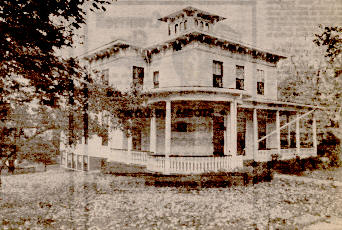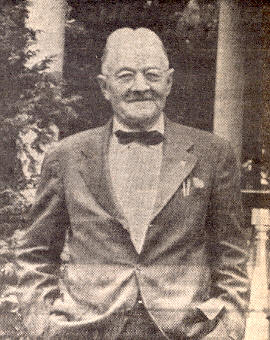Russell A. Frisbie
An Extraordinary Inventor
(This article on the late Russell A. Frisbie was published in 1967
in the Bulletin of the Cromwell Historical Society. The booklet was dedicated to
Mr. Frisbie in his 93rd year.)
By RICHARD W. DONOHUE
These are lamented days of television drivel, of dwindling civic
interest, of moral degeneration in the streets, and, of course, of the
pronounced death of God. One might argue that this is also the age of awakened
social conscience in areas of civil rights, the impoverished, and problems of
population increase. Surely the twentieth century man feels ever-strengthening
pulls and pressures on him from already antithetical and always more diverse
stimuli.
It is in this very age, amid these very factors that Russell A. Frisbie
was born, grew, thrived, lived and lives still. Born on February 21, 1874. He
had one built-in advantage: He was the grandson of Russell Frisbie and the son
of Charles Frisbie, men who knew the meaning of and who espoused success as a
full time occupation.
MECHANICAL GENIUS – Russell A.
Frosbie built the first
automobile in Middlesex County. He also built engines for racing
boats and aircraft parts, and designed banks and toys for the
Stevens Company. The Cromwell inventor died in 1968.
Competition And
Invention
The pertinent facts of the spectacular life of Russell A. Frisbie have
become locally well-known in the past three years, but it may be well to set
them forth in such a journal as this of which a primary goal is permanence. A
strikingly handsome young man, Mr. Frisbie interested himself early in life with
two highly topical and distinctly American themes: Competition and mechanical
invention. While quite young he was a talented and quite successful bicycle
racer, competing through Connecticut and in Madison Square Garden in New York
City.
Meanwhile, living on the Connecticut River, it was predictable that he
would notice and be fascinated by the numerous racing and sporting craft on its
waters. Aware that the expertise of the day believed that the two cycle engine
was optimum efficiency for propeller driven crafts (of which the maximum r.p.m.
rate was 1200), Mr. Frisbie devised a system in which the r.p.m. rate was
increased to a range of 2400 – 3000, and built the engine to drive it.
Offering eight engines of various sizes, he found the most salable to be a model
with two cylinders mounted vertically. Other models ranged in cylinder
construction from one to six. This greatly profitable invention was made in a
back-yard workshop at first, but, as orders increased and as inevitable repairs
became necessary on models constantly in use, he moved his activity to the foot
of College Street in Middletown, from where he could lift via crane three to
four engines from boats of Montauk fishermen directly from the river to his
shop.
Of the many engines manufactured, three carved a remembered niche in the
annals of sport-boating. On the Hudson river a craft with a Frisbie engine won a
279-mile round trip race between New York City and Albany by a close 13 seconds.
A publication of the day stated that, as usual, it was not the speed of the
boats involved that decided the outcome, but rather the strength of the engines.
On the Connecticut River a six cylinder Frisbie engine powered Bruce Tucker’s
Hornet, a sleek-hulled quarter inch cedar craft, to a two hour and 21 minute
racing time from Hartford to Old Saybrook, a record that was to stand for thirty
years. Perhaps the most impressive feat of any Frisbie engine was accomplished
by a three cylinder model with a horsepower range of 18 to 25 in the northern
Pacific Ocean. An endurance run, the engine ran uninterrupted by any malfunction
through all kinds of seas for 1600 miles. The sailors of the 33 foot boat
admiringly spoke later of their having devoted all their energies to the boat
itself, which had often been in danger of capsizing, but that the engine had run
perfectly.
The Locomobile
Concurrent with his interest in engines for boats, Mr. Frisbie developed
as intense, and, it turned out, as remarkable an interest in the new field of
automobile transportation. In the late years of the nineteenth century,
automobile design was receiving its impetus in Europe, and particularly in
France. Mr. Frisbie took great pleasure in poring over the designs of the
pioneering automobiles, and, with earnings accrued at a bicycle shop which he
had operated in conjunction with his interest in cycle-racing, he bought what
turned out to be the first automobile in Middlesex county, a steam-driven “locomobile.”
The bicycle shop was sold, and behind his home, which has since been the
Women’s Relief Corps and is now Cromwell Crest (a convalescence home at 385
Main Street in Cromwell), he opened his above-mentioned workshop which he called
Cromwell Motors. After considerable trial and error, he actually produced a two
cylinder four cycle automobile which ran so well that he was quickly receiving
orders from Hartford and elsewhere. Frisbie cars may possibly have been the
first produced with floor controls. Previously the throttle and brake mechanisms
had been mounted on the dashboard.
The Pope-Hartford Car Company became interested in Mr. Frisbie’s
inventive genius, and offered him a contract at what was then an exorbitant
salary. The independent minded Mr. Frisbie saw fit to decline, whereupon the
Association of Licensed Auto Manufacturers informed him, just as they had
informed another auto builder of the day, Henry Ford, that he would not be
permitted to build and sell his automobiles without a resulting law suit. Under
the Selden patent the association collected royalties on all cars. Several years
thereafter a court decision struck down this eminently unfair ruling, and Henry
Ford was on his way. Predictably, Mr. Frisbie had by this juncture turned his
interests elsewhere.
The first chain driven Frisbie automobile, constructed in 1901, was
resurrected from the James Melton Car Museum in 1938 for the ceremonies opening
the new Middletown-Portland (now the Arrigoni) bridge. With the builder at the
wheel, it drove through the parade course – painted fire engine red. It is of
some note that whereas a more modern machine might have overheated because of
the excessively cumbersome rate of speed necessitated by the exigencies of a
parade, the Frisbie car with its non-centrifugal pump ran to perfection, from
start to finish.
With the advent of World War I, Mr. Frisbie sold his stock of seven loads
of pig iron to the United States government and gave his attention to the war
effort, using the old Frisbie Motors shop to produce precision parts for
aircraft. Frisbie Motors had run its course, but Mr. Frisbie was to score in yet
another field.
In 1936 Mr. Frisbie was requested by his father, the aforementioned
Charles Frisbie, to come out of his retirement (he had for nearly ten years been
away from lucrative employment – being by now financially independent), and he
became a consulting engineer at his father’s J. and E. Stevens Company, a
large and profitable local concern. Thereafter for many years he designed banks
and toys which have since become collectors’ items par excellence.
Some of the more famous toys include the “creeping baby”, the
“velocipede bell toy”, toy steam engines, the “toad bank”, the
“bulldog bank”, the “Tammany Bank”, and the Creedmoor bank”. Although
each of these toys and banks were capable of performing surprisingly intricate
and entertaining functions, Mr. Frisbie felt his masterpiece to be a repeating
cap pistol in which the caps were fed through a slot in the hammer rather than
through the fixed parts of the toy. It is probably here that Mr. Frisbie reached
the most people with his knack for invention – over six million cap pistols
were sold!
This then is the Frisbie success story. Through it all his intelligence
did not overlook the stock market and today he is one of Cromwell’s wealthiest
citizens. But what of Frisbie the man, the citizen, the churchman? Have we
anything still yet to learn from the now 92-yearold Cromwell gentleman – who
despite the years may be seen almost any day driving down street to carry on his
affairs? He is a vice president and director of Cromwell Savings Bank and for
many, many years has carried on the Frisbie family tradition of generous moral
and financial support of the First Congregational Church in Cromwell,
particularly in the area of church music. The almost legendary quality of music
at that church for the past many years has been due not only to superior musical
direction but to the numerous gifts of Mr. Frisbie to the Choir. Indeed it has
been in great measure the spirit of this man which has been the backbone of the
entire church in its continuous service to God and to this community.

FRISBIE HOUSE – This Victorian house, topped by a cupola, or belvedere, was the home for many years of the late Russell A. Frisbie, Cromwell inventor. The house was built about 1850 and is believed to have been built by John Stevens, the first occupant. When Mr. Frisbie died, the home was willed to the Cromwell Historical Society for use as a museum. It is being restored as a Bicentennial project and an exhibit room and library will be opened on the second floor. The Society organized in 1964, has many documents, photos and other items relating to Cromwell’s interesting past. (Stekl Photo)

